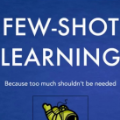Recent learning approaches that implicitly represent surface geometry using coordinate-based neural representations have shown impressive results in the problem of multi-view 3D reconstruction. The effectiveness of these techniques is, however, subject to the availability of a large number (several tens) of input views of the scene, and computationally demanding optimizations. In this paper, we tackle these limitations for the specific problem of few-shot full 3D head reconstruction, by endowing coordinate-based representations with a probabilistic shape prior that enables faster convergence and better generalization when using few input images (down to three). First, we learn a shape model of 3D heads from thousands of incomplete raw scans using implicit representations. At test time, we jointly overfit two coordinate-based neural networks to the scene, one modeling the geometry and another estimating the surface radiance, using implicit differentiable rendering. We devise a two-stage optimization strategy in which the learned prior is used to initialize and constrain the geometry during an initial optimization phase. Then, the prior is unfrozen and fine-tuned to the scene. By doing this, we achieve high-fidelity head reconstructions, including hair and shoulders, and with a high level of detail that consistently outperforms both state-of-the-art 3D Morphable Models methods in the few-shot scenario, and non-parametric methods when large sets of views are available.
翻译:使用基于协调的神经表现方式来隐含地代表地表几何的最近学习方法在多视图 3D 重建问题上显示了令人印象深刻的结果。 但是,这些技术的有效性取决于能否提供大量(数十)的现场输入视图,以及计算要求优化。 在本文件中,我们通过在初始优化阶段使用少量输入图像(下至3)以概率形状赋予基于协调的表达方式,从而能够更快地趋同和更好地概括几何。首先,我们从数千次不完全的原始扫描中学习了一个3D头的形状模型。在测试时,我们联合将两个基于协调的神经网络对现场进行过度配置,一个模型进行几何测量,另一个模型对表面亮度进行估算,使用隐含的不同图像。我们设计了两阶段的优化战略,在初始优化阶段使用之前的概率形状来初始化和限制几何测度。 然后,在使用少量输入图像(下至三)图像时,我们通过进行高纤维化和精确的高度结构,我们实现了高层次的模型, 包括高方向和高方向结构的模型的模型, 以及高方向的模型的模型的模型的模型的模型的模型的模型的模型的模型的模型的模型的模型的模型的形状和模型的形状的形状的形状的形状的形状的形状的形状和结构的形状的形状的形状的形状的形状是连续的形状的形状的形状的大小,包括:





